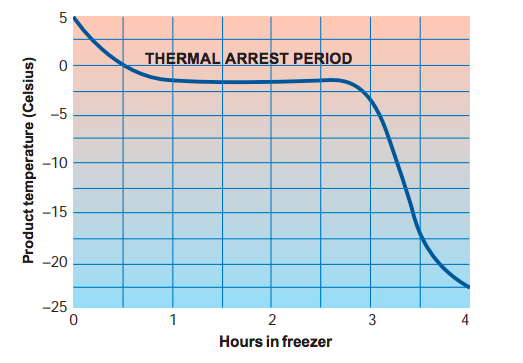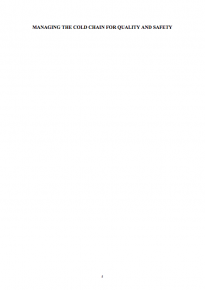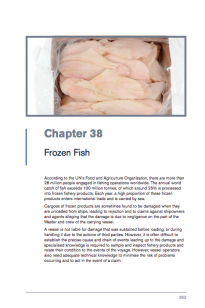Application of Appropriate Technology for Freezing
The frozen fish industry started in the 1930s when “fast freezing” was invented. Freezing can preserve the taste, texture and nutritional value of foods better than most other preservation methods. However, such qualities depend upon the careful choice of food materials, use of appropriate pre-treatments, the choice of freezer and frozen storage options and the use of appropriate packaging.
FLW and Loss of Quality
FLW and Loss of Quality
Food loss and waste (FLW) is associated with loss of quality. This may be seen in the frozen product (e.g. freezer burn, discoloration, mechanical damage), but in many cases the loss of quality is not noticeable until after thawing and cooking. Most of the mechanisms of quality loss are determined by storage temperature and are accelerated with time spent above the recommended value. They are also promoted by temperature fluctuations. Typical causes of loss in quality are:
- Unfrozen water – even below -18°C, up to 10% water can be unfrozen and take part in physical and biochemical reactions.
- Freezing damage – the expansion of water as it turns to ice can cause structural damage to the food. This is often the cause of large voids and excessive drip loss in frozen materials after thawing. The effect can be minimized by freezing rapidly and maintaining low and consistent temperatures during frozen storage.
- 'Ostwald ripening’ – this is the tendency for large ice crystals to grow at the expense of smaller ice crystals. The effect is to induce freezing damage. It can be minimized by maintaining low and consistent storage temperatures.
- Accretion – the joining together of two adjacent ice crystals, leading to increased ice crystal size and freezing damage. Again, it can be minimized by maintaining low and consistent storage temperatures.
- Vapor migration – this is most apparent on the surface of frozen foods as the build-up of ice on the interior of packaging and on food surfaces. If unchecked, this can lead to freezer burn and associated changes in colour and texture. It is caused by temperature gradients between the surface and centre of the product and can be minimized by maintaining low and consistent storage temperatures.
- Solute concentration and osmotic dehydration – during ice formation, the concentration of solutes in the unfrozen water increases, leading to inconsistency throughout the product and damage to the cell membranes. Also, water and solutes can leach out of cellular structures, causing loss of turgor and internal damage. These effects can be minimized by low storage temperatures.
Minimise Thermal Arrest Period
Minimise Thermal Arrest Period
When a fish product is cooled in a freezer, its temperature drops rapidly to about minus 1°C (-1°C), when ice begins to form. However, not all the water in the fish turns to ice at this point. As more heat is extracted, more ice forms, but the temperature of the product drops only slowly until about minus 3°C (-3°C). This period, when the product temperature changes very gradually, is known as the thermal arrest period. The product’s temperature then begins to drop rapidly towards the operating temperature of the freezer.

Source: Frozen Fish
To preserve the quality of the product, it is important that the thermal arrest period is as short as possible, preferably less than two hours. This rate of cooling can only be achieved in equipment designed for the purpose; merely placing fish in a cold store will not achieve a sufficiently high freezing rate.
Freezing Method
Freezing Method
Fish and seafood contain valuable proteins and fats, in addition to a lot of moisture. This makes them valuable foods but also prone to rapid spoilage. The most important measure for stopping bacterial and enzymatic decomposition processes is to provide sufficient cooling within the value chains, or fast freezing that will guarantee preservation of all the essential freshness parameters over several months.
There are several distinctive variants of cooling and freezing and the method chosen is primarily dependent on the type of seafood product, it shape, size and packaging, as well as other process-related parameters, such as the time that is available for chilling during the processing chain, or the initial temperature that the product has at the beginning of the cooling process. Which cooling method is used for which purpose does not, however, only depend on the method’s functionality but also on its profitability and the user’s financial scope. Some freezing systems might be unsuitable because they are too big for the available space or they might be too slow for the planned product throughputs. Plate freezers, for example, are not at all suited to freezing whole tuna. Other freezers could be eliminated because they dry out the fish and thus reduce product quality. Cryogenic freezers that work with liquid nitrogen or carbon dioxide are effective but too expensive for some products if they cannot be operated round the clock or if the running costs exceed the realizable revenue.
Air blast freezers are often the best solution for rapid shock freezing if the objective is to combine versatility with an economical procedure. These freezing systems are suited to freezing products of different shapes and sizes. Their performance is, however, decisively dependent on the air throughput which extracts the heat from the product. If the air in the freezing chamber is absolutely motionless then natural convection and thus the heat transfer rate will be low which lengthens freezing time considerably. If, on the other hand, the air is kept constantly in motion and circulated using fans (forced convection) the freezing time is reduced to a quarter of the previous value. For most applications of air blast freezers, a circulation speed of 5 m/s is quite sufficient. This value is a good compromise between freezing time and costs for the refrigerant and the fan. If, however, the product is to be frozen in less than 30 minutes the air has to circulate in the chamber much faster, mostly at a speed of 10 to 15 m/s. An essential requirement for uniform, rapid freezing is a constant flow of air within the chamber which reaches and envelops all the products equally. This is not always easy, especially when the frozen food is packed very tightly or stacked on pallets which act as barriers to the airflow. Since the flow of air always takes the path of least resistance producers try to make circulation within the chamber as even as possible by using plates and vanes. The freezing plant has to be defrosted regularly and freed from ice which forms from freezing moisture on the walls of the chamber and gradually accumulates on the ribs of the freezer. This impairs heat transfer and lengthens freezing time.
Packaging
Packaging
Package barrier properties protect the food from ingress of gas, light, and water vapor, each of which can result in deterioration of colours, oxidation of lipids and unsaturated fats, denaturation of proteins and a general loss of characteristic sensory qualities. Similarly, barrier properties protect against the loss of moisture from the food to the external environment thereby eliminating dehydration and weight loss.
A wide range of materials is used for food packaging, including plastic, metals and paper/card. Plastic packages can provide a wide variety of properties, depending on the requirements of the food material and the cost of the package.
Rate of deterioration is affected by exposure to air. Block-frozen products are usually protected by close wrapping with plastic film or by coating with a water glaze. To maintain quality, it is important that this cover, film or glaze is not damaged or lost.
Key Publications
Managing The Cold Chain For Quality And Safety This manual summarizes the key recommendations for processing, handling, distribution and storage of chilled and frozen foods. | |
Guide for vessel operators to assist minimize the risk of problems associated with the transport of frozen fish products. |
More Resources
More Resources
31 October 2023
05 September 2023













